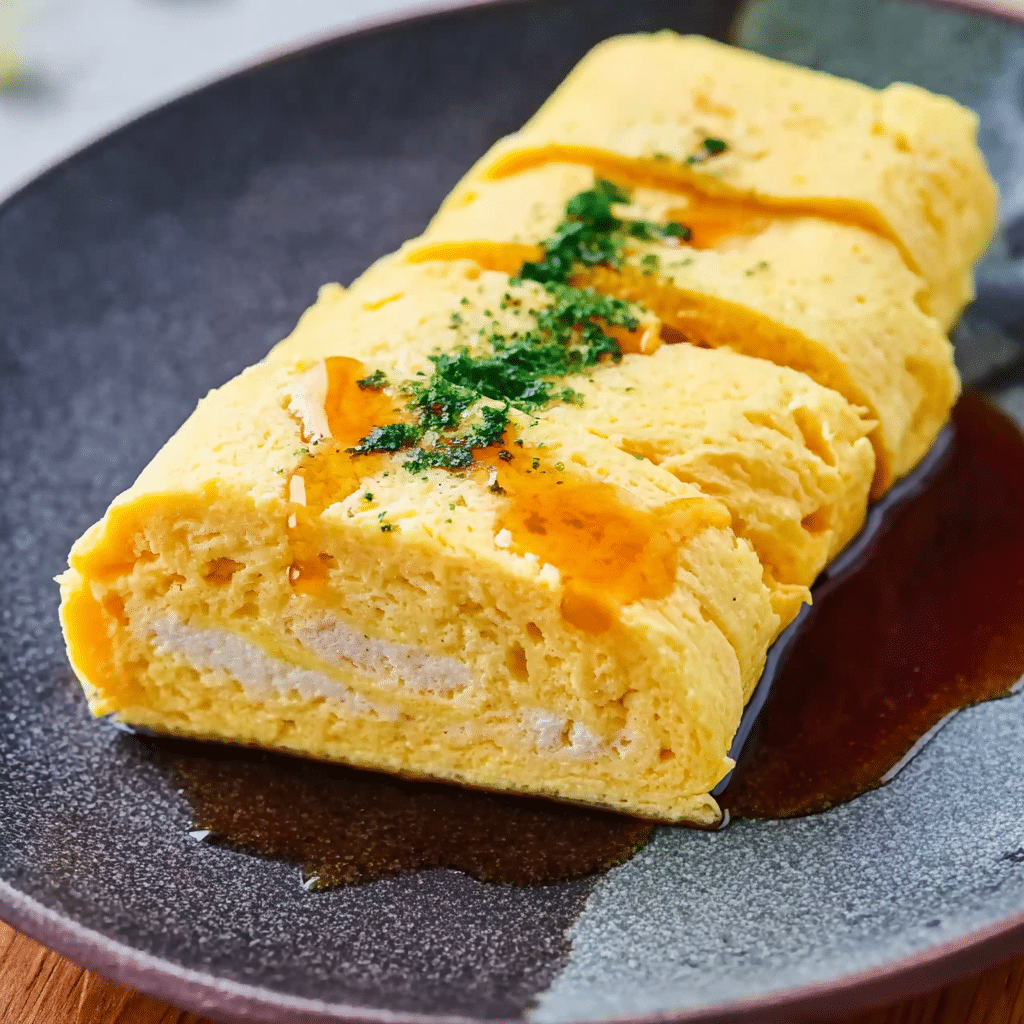Soft, layered, and infused with umami-rich dashi broth, Dashimaki Tamago is a classic Japanese rolled omelette that’s both delicate and flavorful. Traditionally enjoyed in bento boxes, as part of a Japanese breakfast spread, or alongside rice and pickles, this dish is a shining example of Japanese culinary precision and simplicity.
Despite its elegant appearance, Dashimaki Tamago is surprisingly quick to prepare and doesn’t require special ingredients beyond what’s commonly found in a Japanese pantry. Whether you’re seeking a light protein option or exploring the nuances of washoku (traditional Japanese food), this recipe is a great place to start. The subtle sweetness and umami depth make it irresistible for both kids and adults alike.
Full Recipe
Ingredients:
-
4 large eggs
-
3 tbsp dashi (Japanese soup stock)
-
1 tsp soy sauce
-
1 tsp mirin
-
1/2 tsp sugar
-
Neutral oil (like vegetable or canola), for cooking
Directions:
-
In a mixing bowl, crack the eggs and beat gently until the yolks and whites are just combined (avoid overbeating).
-
Add dashi, soy sauce, mirin, and sugar. Mix gently to combine, keeping air bubbles to a minimum.
-
Heat a tamagoyaki pan (or small non-stick frying pan) over medium-low heat and lightly oil the surface with a paper towel.
-
Pour a thin layer of the egg mixture into the pan, tilting to spread evenly. When the surface is mostly set but still slightly wet, start rolling it from one end to the other using chopsticks or a spatula.
-
Move the rolled omelette to one side of the pan, re-oil the pan, and pour another thin layer of egg. Lift the rolled omelette to let the new egg layer run underneath it.
-
Once the new layer is mostly set, roll everything back toward the opposite end. Repeat the process until all the egg mixture is used.
-
Once rolled, shape the omelette using a sushi mat or paper towel while it’s still warm (optional).
-
Let it rest for a few minutes before slicing. Serve warm or at room temperature.
Prep Time: 5 minutes | Cooking Time: 10 minutes | Total Time: 15 minutes
Kcal: 110 kcal per serving | Servings: 2 servings
Introduction to Dashimaki Tamago
Dashimaki Tamago is a beloved staple in Japanese cuisine, known for its soft, custard-like texture and subtly savory flavor, thanks to the addition of dashi—a traditional Japanese soup stock. Unlike the sweetened version called tamagoyaki, dashimaki leans more toward a savory profile, making it a popular addition to bento boxes, breakfast spreads, and even izakaya (Japanese pubs) menus. The name itself tells you a lot: dashi refers to the flavorful stock, while maki means “rolled,” and tamago means “egg.”
This humble yet elegant dish is more than just an omelette. It reflects the essence of washoku, or traditional Japanese food culture, emphasizing balance, seasonality, and simplicity. Despite using just a few ingredients, it achieves a level of refinement that elevates it from everyday comfort food to a culinary art form.
Cultural Significance and Regional Variations
In Japanese households, dashimaki tamago is often prepared for special occasions or to showcase cooking skills. It is especially common in Kyoto cuisine, where the flavor of dashi is celebrated with great reverence. In the Kansai region (where Kyoto is located), the dish is typically wetter and softer than its Kanto (Tokyo-area) counterpart, because it includes more dashi. This results in a juicier, more delicate roll that almost melts in your mouth.
You may find dashimaki served at ryotei (traditional Japanese restaurants), where presentation and precision are held in the highest regard. Chefs in such establishments often use a makisu (bamboo rolling mat) to shape the tamago into perfectly neat rolls, reflecting their dedication to craft and aesthetics.
Why Dashi Makes All the Difference
What sets dashimaki tamago apart from other egg dishes around the world is the use of dashi. Dashi is a cornerstone of Japanese cooking and is typically made from kombu (dried kelp) and katsuobushi (dried bonito flakes). The inclusion of dashi imparts a deep umami character to the egg, making the flavor nuanced and savory without being overpowering.
The broth also affects the texture of the final dish. Because it increases the liquid content, the eggs must be cooked gently and folded with care to maintain their shape and fluffiness. It’s this combination of taste and texture that has earned dashimaki tamago its special place in Japanese cuisine.
Technique and Skill Involved
Although it appears simple, dashimaki tamago requires practice to master. Unlike a Western-style omelette, which is usually folded in half, dashimaki is rolled in layers, typically in a rectangular tamagoyaki pan. The key lies in pouring just the right amount of egg mixture at a time, allowing each layer to set before rolling and adding the next. Too hot, and the egg will brown; too cool, and it won’t set properly.
Controlling the heat and being quick with your hands is crucial. Each roll must be tight and seamless, and the egg should remain moist but fully cooked. Overcooking leads to dryness, while undercooking can cause the roll to collapse. This balance is what makes the dish both an accessible home recipe and a respected culinary skill test in professional kitchens.
How It’s Served and Enjoyed
Dashimaki tamago is incredibly versatile when it comes to serving options. It can be enjoyed hot, room temperature, or even cold, which makes it ideal for meal prepping and bento boxes. It’s often paired with grated daikon radish (daikon oroshi) and a dash of soy sauce to provide a refreshing contrast to the richness of the egg. Some people like it with a small serving of rice and pickles, while others enjoy it as a side dish in a more elaborate Japanese meal.
In Japanese breakfast spreads, dashimaki may appear alongside grilled fish, miso soup, pickled vegetables, and steamed rice. At izakaya, it might be sliced and shared among friends with drinks, appreciated both for its flavor and its nostalgic, comforting quality.
Dashimaki Tamago vs. Tamagoyaki
Though both are rolled omelettes, there’s a clear distinction between dashimaki tamago and tamagoyaki. Tamagoyaki tends to be sweeter, made with sugar and mirin, and is sometimes layered with nori (seaweed) or filled with other ingredients like cheese or crab sticks. Dashimaki, by contrast, is more savory, softer, and often includes more liquid, making it more fragile and juicy.
In home kitchens, tamagoyaki may be preferred by children for its sweetness, while adults may lean toward the umami-rich flavor of dashimaki. Both, however, are cultural icons and frequently appear together on sushi platters and breakfast trays.
Pairing Ideas and Meal Inspiration
Dashimaki tamago pairs beautifully with a wide range of Japanese dishes. Here are a few meal pairing ideas:
-
Bento Box Combo: Add dashimaki tamago alongside grilled salmon, edamame, and steamed white rice for a classic bento arrangement.
-
Sushi Platter: Include sliced dashimaki as a garnish or side to nigiri and maki rolls for a visually pleasing contrast.
-
Traditional Breakfast: Serve with miso soup, tsukemono (pickled vegetables), and a bowl of rice for a wholesome morning meal.
-
Vegetarian Spread: Combine with sautéed seasonal greens, tofu, and a dipping sauce for a light, protein-rich vegetarian dinner.
Its mild flavor and fluffy texture also make it suitable for fusion meals. Some chefs have started incorporating it into sandwiches, salads, or even sliders for a modern twist.
Nutritional Benefits
Dashimaki tamago is rich in protein and contains essential nutrients from the eggs and dashi. Depending on the dashi base, it may also offer minerals like iodine (from kombu) and a boost of umami flavor with minimal calories. Because it’s lightly seasoned and low in added fats or sugars, it’s suitable for a balanced diet and can be adapted for different dietary needs.
You can further modify the dish by using low-sodium soy sauce or omitting mirin if you’re avoiding alcohol or sugar. For added nutrition, finely chopped vegetables or seaweed can be mixed into the egg before cooking.
Why You Should Try Making Dashimaki Tamago at Home
Despite its elegance, dashimaki tamago is a manageable dish to make in your own kitchen. It requires only a few ingredients and a little patience, making it a great way to introduce yourself to Japanese cooking. With a bit of practice, you’ll be able to create beautifully rolled, restaurant-quality eggs right at home.
Cooking it can also be a meditative experience. The gentle rhythm of layering and rolling the egg offers a calming routine, while the aroma of warm dashi filling your kitchen is deeply comforting.
Whether you’re cooking for yourself, a loved one, or to impress guests, dashimaki tamago is a dish that communicates thoughtfulness and care.
Conclusion
Dashimaki tamago is more than just an omelette—it’s a celebration of Japanese culinary tradition. With its velvety texture, gentle umami flavor, and graceful presentation, it captures the spirit of washoku beautifully. It’s versatile enough to serve at breakfast, lunch, or dinner, and simple enough to master with a bit of practice.
What makes it truly special is how it transforms a few humble ingredients into something elegant and satisfying. Learning to make dashimaki tamago can be your gateway to deeper appreciation of Japanese cooking techniques and flavors. So whether you’re just starting your journey into Japanese cuisine or looking to refine your skills, this dish is a perfect place to begin.






